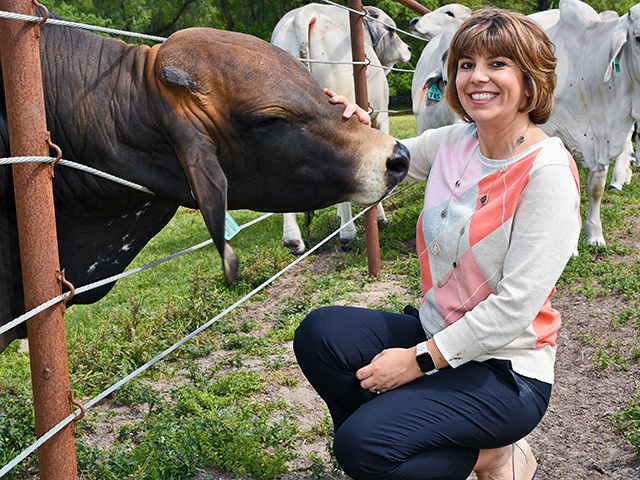COOL Genes for HOT Cattle
Cattlelink - COOL Genes for HOT Cattle Goes Here
When Raluca Mateescu started work at the University of Florida (UF), she didn't have to look far for a meaningful research project. All she had to do was step outside the Animal Science building and be hit with the stifling, sticky heat Florida cattle live in almost year-round.
Obviously, Mateescu can't change the weather. But, maybe there was another way to help cattle handle heat stress, a genetic path. She hit the squeeze chutes running, both at UF and at an operation run by the Seminole tribe. Her goal is a set of genomic tools to help cattle everywhere deal with the heat.
Heat stress is more than a Florida problem. Mateescu notes: "In the U.S., 40% of the beef cows are in hot and humid environments, and heat stress is a major limiting factor of production efficiency."
START WITH THE OBVIOUS
Spoiler alert: The heavier the hair coat, the hotter the critter. Another no-brainer? Brahman cattle handle heat better than Angus. The devil is in the details, though.
Mateescu discovered that to a geneticist's delight, there is quite a bit of variation within cattle breeds. That allows for selection of desirable traits. And, thankfully, selection for hair coat, as well as other less obvious thermotolerance traits like sweat gland size, number and location, can happen without negatively affecting production and quality traits.
The 335 cow herd at UF, in Gainesville, is custom-made for studying the effects of heat stress. Cows here range from 100% Brahman to 100% Angus, with varying degrees of both in the crosses. Mateescu's study here is in its fourth year. She and her crew divide heifers into six categories based on the amount of Brahman. An empty controlled internal drug release device holding a tiny thermometer is placed in the vagina of study subjects. It records internal temperature of the animal for five days, while weather stations keep track of the outside temperature and humidity.
P[L1] D[0x0] M[300x250] OOP[F] ADUNIT[] T[]
Those internal thermometers are a must-have, allowing researchers to monitor cows' temperatures when they are in pastures. Mateescu also takes a hair sample and skin biopsy. She is finding that even though, on average, Angus and Angus-cross heifers have longer, thicker hair coats, there is quite a bit of variation and room for selection when it comes to this trait. The same holds true with sweat glands.
"They [the sweat glands] are much larger in the Brahmans than the Angus, and they are closer to the surface of the skin," she says. This is a big deal because 75% of a bovine's internal heat is lost by sweating. Because of the variation in each breed group when it comes to this trait, this again offers a positive opportunity with respect to selection.
A LARGER TEST GROUP
While the UF study is ideal for comparing breeds and breed crosses, a geneticist needs numbers and consistency. The Seminole tribe has both.
With around 10,000 cows, Alex Johns typically holds back 800 head of Brangus heifers for replacements each year. He is natural resource director for the Seminole tribe operation.
Mateescu works with the tribe on those replacement heifers, recording internal temperatures every 15 minutes for five days, working 200 heifers a day. Here, too, weather stations simultaneously record temperature and humidity.
The researchers also record sweating rate, coat color and score, hair length and diameter, chute score and exit score, body condition score, weight gain over the summer and pregnancy status.
Even though the cattle here in Okeechobee, which is right on the line between the subtropics and tropics, don't get a winter coat, there are differences in hair coats. They were all either a score 1 or 2, but Mateescu says the difference was marked.
"The score 2s have a higher body temperature in the summer. Their longer hair doesn't allow the sweat to evaporate," she says, noting cooler heifers gained better and had higher pregnancy rates.
"It is a significant effect. The heavier heifers are more heat tolerant, and being cooler allows them to be more productive and still eat and gain."
DATA AND PHENOTYPE
Cattle with higher chute and exit scores had higher body temperatures, even when they weren't in contact with humans. They are also the ones more likely to be open at preg-check time.
Mateescu's findings did not surprise Johns. "The research backed up what we see by eye, the phenotype. On average, a good cow man can do a pretty good job of picking them by eye. If we retain 20% of our heifers for replacements, and 5% don't work, it would be a pretty big savings if we could find that 5% early."
Mateescu hopes that will be doable in two or three years by means of a typical DNA test that incorporates data from her sweat gland work. It could be available first in the Brangus breed.
Until then, consider the use of a hair coat score. Selection tools already exist in many breeds to get rid of animals with longer hair coats. Thanks to work done by University of Missouri animal scientist Jared Decker, the American Angus Association already has hair coat EPDs.
Another low-tech fix for heat stress is to incorporate a touch of Bos Indicus in your crossbreeding program.
"They're adapted to heat and humidity, they are resistant or at least tolerant of internal and external parasites, and when they're used in crossbreeding systems, they reproduce well, gain well and live a long time," Mateescu says.
[PF_0920]
(c) Copyright 2020 DTN, LLC. All rights reserved.




